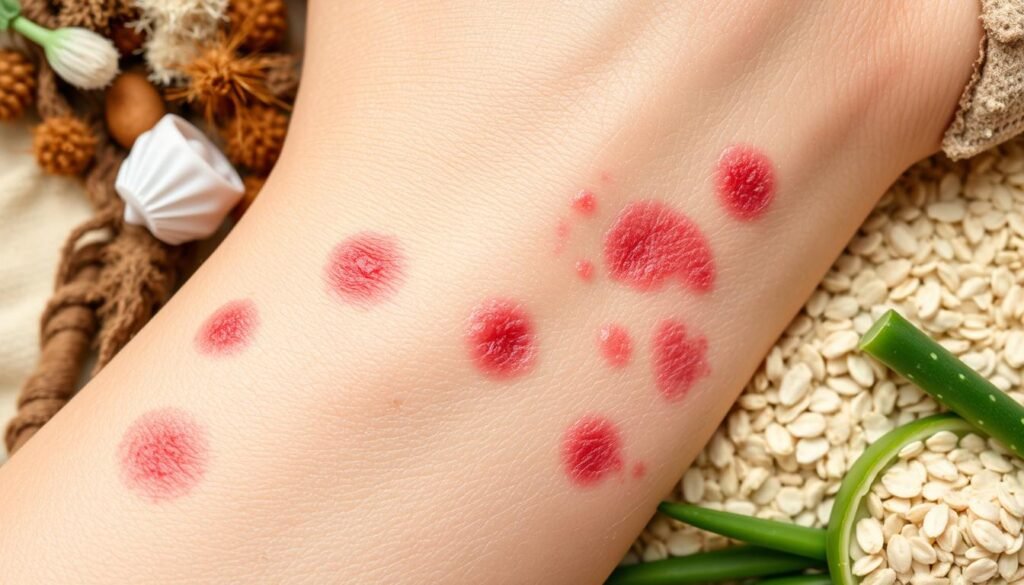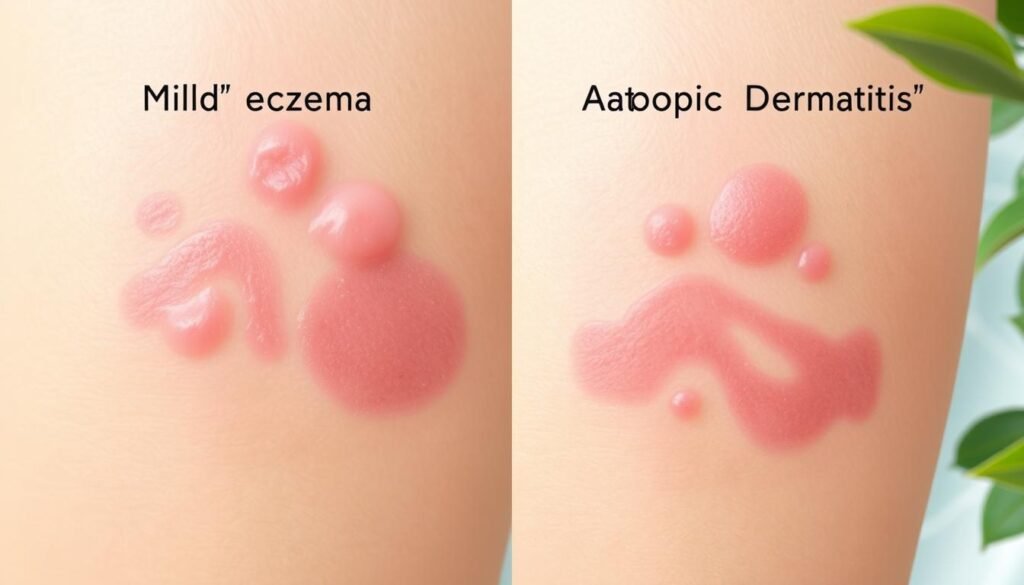Did you know over 31 million Americans have eczema? This skin problem affects both kids and adults. It’s not just on the skin. It also affects feelings. In America, more than 7% of adults have atopic dermatitis. Knowing the causes, signs, and ways to handle mild eczema helps manage symptoms. It makes life better.
There’s no sure cure for eczema yet. But, treatments like creams and changing your lifestyle can really help. They offer significant eczema relief. We will look into eczema types, what causes it, and how to deal with it. For more details, check out this detailed guide on mild eczema.
Knowing the right info and ways to manage eczema makes dealing with it easier. With good strategies, handling atopic dermatitis becomes less tough.
Key Takeaways
- Mild eczema impacts about 15% of children and often starts in infancy.
- Atopic dermatitis often links to personal and family allergy and skin issues.
- Keeping skin moist is key to managing mild eczema symptoms.
- Knowing various triggers like genes, the environment, and allergens helps in management.
- Medicines like crisaborole and dupilumab are good for moderate to severe cases.
What is Eczema and Its Types?
Eczema is a common term for many inflammatory skin conditions. These conditions cause redness, itching, and irritation. Over 31 million Americans have some form of eczema. Types of eczema include many, but atopic dermatitis is most common, especially in kids. Knowing about these forms is key for good care and treatment.
Defining Eczema and Atopic Dermatitis
There are many types of eczema, but atopic dermatitis is notable. It affects about 9.6 million kids and 16.5 million adults in the USA. This chronic skin issue usually starts between 2 months to 5 years of age. Many see their symptoms decrease as they grow up. Atopic dermatitis is often found alongside other allergies, like asthma and hay fever.
Other Common Types of Eczema
Besides atopic dermatitis, there are many other types of eczema:
- Contact Dermatitis: This type is split into allergic and irritant forms. It often comes from touching things like latex or metals.
- Dyshidrotic Eczema: This affects more men than women. It causes blisters on hands and feet, due to allergies or stress.
- Seborrheic Dermatitis: This primarily impacts the scalp. It leads to oily, scaly patches. Stress, hormonal shifts, and sickness can trigger it.
- Neurodermatitis: This leads to itchy, scaly patches on different body areas. Scratching makes it worse, but the exact cause is unknown.
- Nummular Eczema: Known for its coin-shaped, very itchy spots. It can happen from very dry skin or with other eczema types.
- Stasis Dermatitis: Linked to poor circulation in the legs. It causes swelling, redness, and itchiness in the lower legs.
Knowing the different forms of dermatitis helps people and doctors find the best ways to manage each condition.
Symptoms of Mild Eczema
Knowing the signs of mild eczema helps with early treatment. People with mild eczema often feel uncomfortable. This is mainly because of itchy skin. If not treated, it can get worse. The looks of an eczema rash also change based on the skin type and what triggers it.
Identifying Common Symptoms
Several key signs point to mild eczema, such as:
- Skin redness, appearing as red or brown patches.
- Dry skin, which might crack or peel and add to the irritation.
- Itching, leading to scratching and possibly more damage to the skin.
- Thickening of the skin, showing ongoing irritation.
- Blistering, oozing, or crusting in certain cases.
Understanding the Variability of Rashes
The eczema rash looks and feels different from person to person. Some might get it on their elbows, knees, or hands. Babies and toddlers often have it on their face. The severity varies based on skin color, age, and other factors.
For those with darker skin, the skin redness might look brown, purple, or gray. Knowing these differences helps in better controlling the symptoms.
Causes and Triggers of Mild Eczema
Mild eczema comes from both genetics and environmental triggers. These factors work together in different ways for each person. Knowing about these causes makes it easier to control eczema.
Genetic and Environmental Factors
People with eczema often have genes that make them more likely to get it. Some have a change in a gene that makes filaggrin. Filaggrin is important for healthy skin. So, people with allergic family members might get eczema easier.
Where you live affects eczema too. Cold or damp places can make it worse. Stress also plays a role, though we don’t fully understand it yet. It shows there might be a link between how we feel and our skin’s health.
Common Allergens and Irritants
Many things can set off eczema. These include:
- Pollen
- Mold
- Pet dander
- Dust mites
Things like soaps, detergents, and certain fabrics also irritate the skin. Some jobs expose people to eczema triggers, like hairstylists or mechanics. For kids under two, eczema often comes from food allergies. This shows how complex eczema is, with each person dealing with different triggers.

Mild Eczema vs. Other Skin Conditions
Understanding the differences between mild eczema and other skin issues is key for the right treatment. Atopic dermatitis, often known as eczema, has traits that can overlap with other conditions. This skin conditions comparison is crucial for a correct diagnosis and managing it well, especially when symptoms are similar.
Understanding Atopic Dermatitis vs Eczema
Mild eczema, also called atopic dermatitis, is a usual chronic skin condition. It shows red, itchy spots. Since its symptoms are like those of other skin problems, people can easily get confused. A recent study showed that out of 233 patients treated with dupilumab for what was thought to be severe atopic dermatitis, 50 of them did not respond well. Many of these had allergic contact dermatitis, not actual eczema. This highlights how crucial accurate diagnosis is and shows the need to separate atopic dermatitis from eczema in practice.

How Mild Eczema Differs from Contact Dermatitis
Contact dermatitis comes up after touching irritants or allergens. But, mild eczema can start without any clear trigger. Contact dermatitis usually gets better when the irritant is taken away. This is different from atopic dermatitis, which often needs constant care. Specialists found that 47 of the 50 patients not responding to dupilumab had allergic contact dermatitis. This shows how vital it is to tell the difference between eczema and contact dermatitis. Properly evaluating skin conditions allows doctors to tailor treatment properly.
| Condition | Cause | Common Symptoms | Treatment Options |
|---|---|---|---|
| Atopic Dermatitis | Genetic and environmental factors | Red, itchy patches on various body areas | Topical corticosteroids, moisturizers |
| Contact Dermatitis | Exposure to irritants/allergens | Redness, rash, itching after contact | Avoidance of irritants, topical steroids |
| Psoriasis | Immune system dysfunction | Thick, scaly patches usually on scalp, elbows | Topical treatments, systemic medication |
| Rosacea | Vascular instability | Flushing, visible blood vessels, bumps on face | Topical medications, lifestyle changes |
It’s critical to correctly distinguish mild eczema from conditions like eczema and contact dermatitis. It ensures that people get the right treatment for their specific symptoms. For a full understanding of conditions similar to eczema, talking to a healthcare professional is best. More information is available here: skin conditions comparison.
Managing and Treating Mild Eczema
Handling mild eczema usually means trying different methods to ease symptoms. People can pick from many treatment choices, like over-the-counter options and home cures. It’s also key to know when it’s time to get advice from a healthcare provider to keep your skin healthy.
Over-the-Counter Treatment Options
Over-the-counter solutions often help those with mild eczema. These remedies can include:
- Topical hydrocortisone: This low-strength steroid helps lessen itching and rash. You can apply it up to four times a day, but not for more than seven days in a row.
- OTC shampoos: With active parts like ketoconazole and zinc pyrithione, these shampoos deal with scalp symptoms of seborrheic dermatitis.
- Oral antihistamines: Drugs such as Diphenhydramine and Cetirizine fight itching and bring down swelling.
- Pain relievers: Medicine like ibuprofen and naproxen helps with the burning and swelling that comes with eczema.
Home Remedies for Symptom Relief
Besides what you can buy at the store, many turn to home remedies for extra relief. Some helpful options are:
- Natural oils: Putting on coconut oil or olive oil helps keep moisture in the skin.
- Colloidal oatmeal baths: Bathing in this can calm your skin and make itching less of a problem.
- Wet wrap therapy: This treatment stops scratching and can lower the chances of a flare-up.
When to See a Healthcare Professional
If eczema doesn’t get better with store-bought products or home treatments, see a doctor. You should especially do so if:
- Your eczema gets worse or stays the same.
- You notice signs of a skin infection, like more redness or warmth.
- You think you might need prescription medicine, such as stronger creams or other treatments, for better results.
The U.S. Food and Drug Administration (FDA) checks to make sure treatments are safe. A good treatment plan and taking care of your skin gently can really help manage mild eczema symptoms well.

| Treatment Type | Examples | Uses |
|---|---|---|
| Over-the-Counter Treatments | Hydrocortisone, Antihistamines | Itching relief, inflammation control |
| Home Remedies | Coconut Oil, Colloidal Oatmeal | Moisturizing, soothing irritation |
| Medical Interventions | Topical Steroids, Calcineurin Inhibitors | Severe symptoms treatment |
Importance of Moisturization in Eczema Care
Moisturizing is key in eczema care. It helps keep the skin healthy and lowers the risk of flare-ups. Knowing which products to use is critical. It ensures they’re applied correctly. A good moisturizer does more than stop moisture loss. It also protects against skin irritants.
Choosing the Right Moisturizers
When picking moisturizers for eczema, ingredients matter. Studies suggest products with lipids like ceramides are helpful. They benefit the skin barrier of those with atopic dermatitis. These components fight inflammation, improving skin repair. Opt for hypoallergenic, fragrance-free kinds to avoid irritation. Quality moisturizers are vital. They help the skin hold water and guard against harm.
Moisturizing Techniques for Optimal Relief
How you moisturize can boost product benefits. The “soak and seal” method is one to try. It locks in moisture right after a bath. Daily use of emollients is important for skin repair and hydration. Some formulas work better than others, like those with urea. They outperform paraffin-based moisturizers. Following these steps can control eczema and keep skin healthy.
Understanding the Role of Allergies in Eczema
Allergies play a big role in eczema flare-ups. They can make the condition worse by causing more inflammation and discomfort. Knowing what triggers your allergies is key. This is very important in managing eczema, especially in kids.
How Allergies Trigger Eczema Flare-Ups
Eczema sufferers often react strongly to environmental and food allergens. Things like pollen, dust mites, and pet dander can worsen the skin’s condition. Up to 80% of kids with eczema might get hay fever or asthma as they grow.
Having allergic disorders in the family increases the risk for kids. Nearly one in three babies with allergic moms may get eczema.
Link Between Food Allergies and Mild Eczema
About 37% of kids with bad eczema also deal with food allergies. Common triggers are milk, eggs, and nuts. Eczema and food allergies are closely linked. Eczema damages the skin’s barrier, making food allergies more likely.
Taking care of eczema early on might lower the risk of developing food allergies.
Knowing how allergies, triggers, and food allergies connect helps in preventing eczema flare-ups. This allows for better treatment and management strategies.
| Allergic Trigger | Connection to Eczema | Impact on Individuals |
|---|---|---|
| Pollen | Common environmental factor | Increases risk of flare-ups |
| Dust Mites | Frequent indoor allergen | Worsens skin inflammation |
| Pet Dander | Common household allergen | May trigger symptoms in sensitive individuals |
| Milk | Food allergy link | Can exacerbate eczema in affected children |
| Eggs | Frequent in children with eczema | May lead to reactions and flare-ups |
| Nuts | Potential long-lasting allergy | Increases risk of anaphylaxis |
Lifestyle Changes to Alleviate Mild Eczema
Making changes in your lifestyle can greatly help manage eczema. Adding stress management to your daily life can make you feel better emotionally. Also, keeping your surroundings skin-friendly can reduce eczema flare-ups. Both steps are key for better health.
Stress Management Techniques
Stress can make eczema worse, causing more discomfort. To manage stress better, you can:
- Mindfulness practices help you stay in the moment and lower anxiety.
- Regular exercise boosts happiness by releasing endorphins.
- Ensuring adequate sleep helps refresh your mind and reduces skin irritation.
Adding these activities to your daily routine can bring positive changes. It’s important to know how stress affects your skin if you have eczema. For tips on managing triggers and coping, click here.
Tips for a Skin-Friendly Environment
To manage mild eczema, making your environment skin-friendly is crucial. You can:
- Use gentle cleaners without harsh chemicals to avoid irritation.
- Choose clothing made of soft, breathable materials instead of wool or polyester.
- Keep your indoor air moist, especially when it’s cold, to stop your skin from drying out.
Being aware of your daily choices helps you stay away from things that could irritate your skin. Even small changes can make a big difference in controlling eczema and making your life better.
Conclusion
Eczema is a complex condition that many people, especially kids, have to deal with. Knowing what causes it, its symptoms, and how to manage it is very important. This knowledge helps people improve how they live each day and take control of their eczema.
A lot of kids get mild eczema early on. In fact, studies show that around 60% get it in their first year. It’s crucial to see doctors who know a lot about eczema. They can create treatment plans just for you. This expert advice and some changes in how you live can make a big difference.
Being proactive is key in handling eczema well. Choosing the right treatments and sticking to daily skincare routines is empowering. Over time, this leads to less discomfort and makes life better.